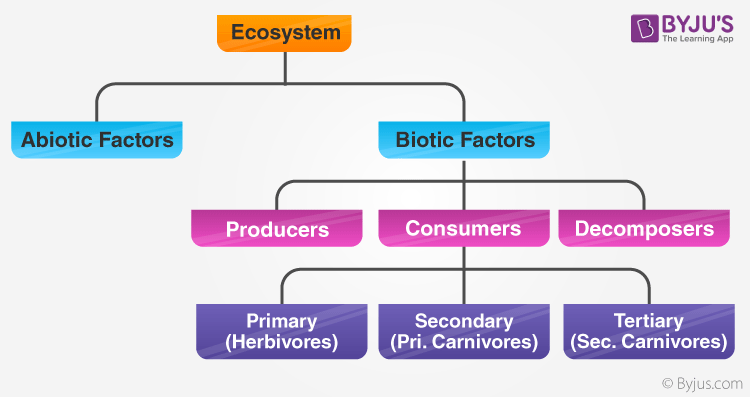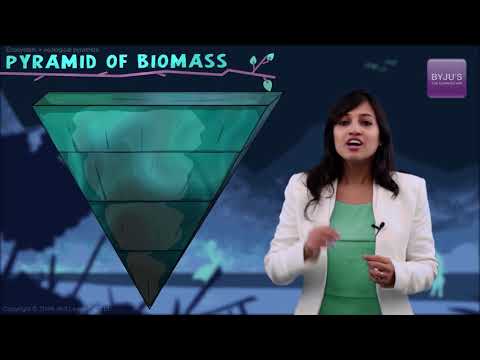According to the CBSE Syllabus 2023-24, this chapter has been renumbered as Chapter 12.
An ecosystem is a biological community where the living and non-living components interact with each other and their physical environment. It is the functional unit of nature and varies greatly in size. Let us have a look at the structure, function and components of an ecosystem.
Structure of Ecosystem
The structure of the ecosystem comprises two different components:
- Biotic
- Abiotic

Biotic Components
Biotic Components are the living components involved in shaping the ecosystem. It includes biotic factors such as:
- Producers: All green plants in the ecosystem are termed producers, as they produce their own food by making use of solar energy. All living organisms are dependent on plants for both oxygen and food.
- Consumers: They include both primary consumers and secondary consumers. As animals depend on plants for their food, they are called consumers. Primary consumers feed directly on producers for their food, and secondary consumers feed on the primary consumers for their food. All herbivores animals are an example of primary consumers. Carnivores and apex predators make up the secondary and tertiary consumers.
- Decomposers: They are the saprophytes which include fungi and bacteria. Decomposers convert the dead matter into nitrogen and carbon dioxide, and the process is called decomposition.
- Energy Flow: Energy flow is the flow of energy along the food chain through different trophic levels. Energy is passed from the producers to the decomposers through various trophic levels.
Abiotic Components
Abiotic components include inorganic materials like air, water, and soil.
Also Read: What is Ecosystem
For more information on Ecosystem, watch the below videos


Ecosystem Types
There are three main types of ecosystems.
Terrestrial Ecosystem
These are the ecosystem found only on land. The terrestrial ecosystems include,
- Forest ecosystem
- Grassland ecosystem
- Desert ecosystem
- Mountain ecosystem
Aquatic Ecosystem
The aquatic ecosystem is the ecosystem in the water body. It includes,
Freshwater Ecosystem
The freshwater ecosystem can be divided into the following categories:
- Lentic: This includes slow-moving or still water such as lakes, ponds, pools, etc.
- Lotic: This includes fast-moving water bodies such as rivers and streams.
- Wetlands: These include the environment where the soil is saturated with water for a certain time period.
Oceanic Ecosystem
The ocean ecosystem is the largest ecosystem. It covers about 71% of the total earth’s surface. This is also known as the marine ecosystem and is divided into deep water, shallow water and deep ocean surface. A large variety of corals, echinoderms, brown algae, cephalopods and dinoflagellates are found here.
Ecological Pyramids
An ecological pyramid is a graphical representation of the relationship between different organisms. Each bar of the pyramid represents a different trophic level. The different types of ecological pyramids include:
Pyramid of Numbers
This represents the number of organisms in each trophic level, irrespective of their size.
Pyramid of Biomass
This represents the total mass of organisms at each trophic level.
Pyramid of Productivity
It is the total amount of energy present at each trophic level and the total energy lost between each trophic level.
Ecological Succession
Ecological succession refers to the change in the structure of species of an ecological community over time. There are two types.
Primary Succession
This is a type of succession in which plants and animals first colonize a barren piece of land.
Secondary Succession
This is the type of succession in which an ecosystem that is destroyed revives itself.
Function of Ecosystem
- The level of organisms regulates the flow of energy.
- The autotrophs are the producers that produce energy which is transferred through various trophic levels.
- The minerals of the biosphere are cycled through the biosphere.
- It supports life systems and provides stability.
Few Important Questions
- What is nutrient cycling?
- What is primary productivity?
- Explain the components of an ecosystem.
- Define ecological pyramids with examples.
- List out the differences between the food chain and the food web.
Learn more about the ecosystem by registering at BYJU’S.
Further Reading:
| Ecology | Food Web |
| Biotic And Abiotic | Energy Flow in Ecosystem |
Frequently Asked Questions on CBSE Class 12 Biology Notes Chapter 14 Ecosystem
What is the definition of an ‘Ecosystem’?
An ecosystem can be defined as an area where plants, animals and other organisms, as well as weather and landscape, work together to form a bubble of life.
What are the different types of ecosystems?
There are 4 main types of Ecosystems: 1. Forest ecosystem 2. Grassland ecosystem 3. Tundra ecosystem 4. Desert ecosystem
What are the main differences between biotic and abiotic?
Abiotic factors refer to non-living physical and chemical elements in the ecosystem. Whereas, Biotic describes a living component of an ecosystem.
Comments